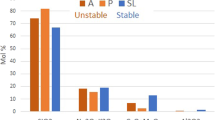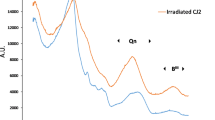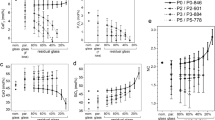Abstract
ALTHOUGH moisture expansion of ceramic bodies has been studied by many investigators its cause is still not known with certainty. The hydratable materials that play a part may be anhydrous clay minerals1,2, γ-alumina3, amorphous silica (silica gel)4,5, alumino-silicic acid gel5 and permutites, zeolites or glass1–3,6,7. These are all amorphous (or poorly crystalline) materials that might be expected to appear at some stage in the firing of a clay body. In the past, studies on natural materials have been complicated by complex mineralogy and/or the presence of impurities, and it has been difficult to assess the influence of each component on moisture expansion. To overcome this we have studied moisture expansion using pure co-precipitated and mixed gels of silica and alumina and some to which an impurity of sodium oxide has been added. The work forms part of an investigation into the nature and cause of the permanent moisture expansion of ceramic bodies being carried out in this Division.
This is a preview of subscription content, access via your institution
Access options
Subscribe to this journal
Receive 51 print issues and online access
$199.00 per year
only $3.90 per issue
Buy this article
- Purchase on Springer Link
- Instant access to full article PDF
Prices may be subject to local taxes which are calculated during checkout
Similar content being viewed by others
References
Hill, R. D., Trans. Brit. Ceram. Soc., 52, 589 (1953).
Milne, A. A., Trans. Brit. Ceram. Soc., 57, 148 (1958).
Keppeler, G., and Aurich, G., Sprechsaal, 72, 71 (1939).
Smith, A. N., Trans. Brit. Ceram. Soc., 54, 300 (1955). Dal, P. H., Zuleger, W. A., and Berden, W. J. H., Klei, 6, 331 (1956).
Holdridge, D. A., Congrès Céramique International, Zurich, 191 (1950).
Keppeler, G., and Pangels, R., Sprechsaal, 66, 625 (1933). Hueber, H. V., and Milne, A. A., Nature, 176, 509 (1955).
Vaughan, F., Trans. Brit. Ceram. Soc., 57, 38 (1958).
Levin, I., and Ott, E., Z. Krist., 85, 305 (1933).
Flörke, O. W., Neues Jb. Miner. Mh., 217 (1955). Flörke, O. W., Ber. dtsch. keram. Ges., 32, 369 (1955). Brindley, G. W., Clay Min. Bull., 3, 167 (1957).
Buerger, M. J., “Phase Transformations in Solids”, 207 (John Wiley and Sons, Inc., New York, 1951).
Author information
Authors and Affiliations
Rights and permissions
About this article
Cite this article
DEMEDIUK, T., COLE, W. A New Approach to the Investigation of the Cause of Moisture Expansion of Ceramic Bodies. Nature 182, 1223–1224 (1958). https://doi.org/10.1038/1821223a0
Issue Date:
DOI: https://doi.org/10.1038/1821223a0
This article is cited by
Comments
By submitting a comment you agree to abide by our Terms and Community Guidelines. If you find something abusive or that does not comply with our terms or guidelines please flag it as inappropriate.



